4 reasons why the time is now to modernize assurance
Appledore Research’s Robert Curran details four reasons why service assurance is at the inflection point for modernization in communication service providers’ (CSPs) network operations.
Telecom networks are among the most complex structures ever created by human beings - and are only becoming even more complex. Unlike many other complex constructions, networks exist to provide services that are experienced in real-time by millions of people and on which individuals, businesses, and economies now so fundamentally rely.
This means the job of ensuring that networks and services are delivering as required – “assurance”, more or less - is likewise both of truly vital importance, and increasingly complex.
The key question that poses for operators is whether a continued steady evolution of techniques and methods, process improvements and enhancements is sufficient to meet the challenge? And if not, then what is the right path forward?
Everything has changed
The essential requirements for effective assurance systems have not changed in thirty years: monitor the state of the network and services provided, separate and prioritize failures, and restore services with the minimum of delay. But almost everything else about assurance has changed.
The most significant change is that networks have become more dynamic, not only capable of change but likely to change – especially with the shift to cloud-based networks. This accelerating transition massively complicates the task of mapping the relationships between networks and the services they carry. Operators must now consider network structure as a function of time, not only of its topology.
A second change is that telemetry data – the data the network transmits about itself – is now generated in much higher volumes and much more frequently than ever. That network data is also now joined by other sources of data from services, network applications, and end-user applications themselves – and even other non-network sources. For cloud-based networks, observability represents a new and (for CSPs ) unfamiliar class of essential data. Correlating all this data to determine cause and effect is much more complex.
A third change is the amount of accumulated knowledge now required to understand device and network behavior, and the correspondingly greater demand on highly specialized human resources. The conventional assurance process has depended on rulesets to help front-line network operations center (NOC) staff reduce hundreds of alarms and events into a single explanation (and likely resolution path). But the rulesets themselves have become unwieldy and difficult to keep updated as new devices (especially new software-based functions) are introduced into the network.
A fourth change is the higher pressure on operators to identify and resolve failures quickly. Increased traffic, especially video, with users’ high sensitivity to delays and jitter, is only partly responsible. Telecom’s very success – ubiquitous, 24/7 x 365 connectivity – has increased customers’ expectations and reliance. Operators are increasingly keen to explore ways to predict (and therefore prevent) problems – avoiding customer complaints entirely.
These changes come within the much wider set of changes impacting telecom: cloudification, 5G, and unrealized growth expectations. But not everything that’s changed represents bad news for assurance.
Assurance plays a crucial role in a CSP’s business, straddling the real world experience of customers and the immense complexity of network structure, state and behavior.
Smarter, faster, better
The greater granularity of data makes it possible to gain richer, faster insights into the impact of network failures or service-impacting events. So, while customer expectations are up, the data that operators need to help identify and remediate problems is more readily available. Improvements in the ability to gather massive amounts of data in real-time and share it with the applications that need it are a welcome development when it comes to service assurance.
The application of machine learning to this data also means that operators can detect anomalies and trends earlier, even proactively in many cases, rather than simply reacting to failures that have already occurred.
Reorienting assurance around data (rather than adding to the stack of process logic) also means that assurance applications can leverage shared underlying capabilities with other systems – most notably fulfillment. This leads to simpler applications that are easier to maintain and easier to scale. New concepts like intent and autonomous network domains aid this simplification and transition to a new, more modern support systems architecture.
Figure 1. Modernizing Assurance offers new synergies.
The time to act is now
Assurance plays a crucial role in a CSP’s business, straddling the real-world experience of customers and the immense complexity of network structure, state, and behavior. Both are changing - fast and fundamentally. However, the size of the challenge that this creates is matched by the sophistication in technology, capabilities, and thinking that are now available.
Now, in 2024, the foundations of traditional assurance are dissolving fast. The certainties that underpin CSPs’ legacy assurance systems no longer hold true. The goals of operators’ digital transformations are incompatible with a “make-do-and-mend” strategy for assurance. It’s far too business-critical for that. And customers will spot the difference quickly between operators who can provide and assure a modern service, in a modern way, against modern expectations, and those whose retention strategy appears to be based simply on customer inertia.
Operators should take the opportunity to modernize their assurance capabilities and put in place the foundations for a new era in telecom and telecom operations—one that is defined by automation, intelligence, and speed.
Read our more detailed take on the modernization of assurance in the Modernizing Assurance whitepaper.

